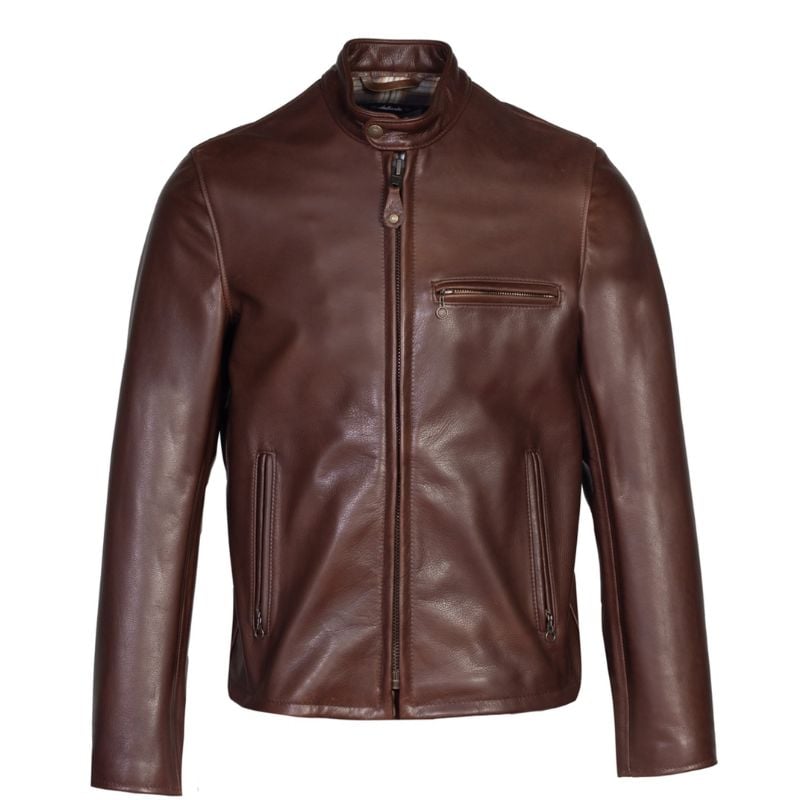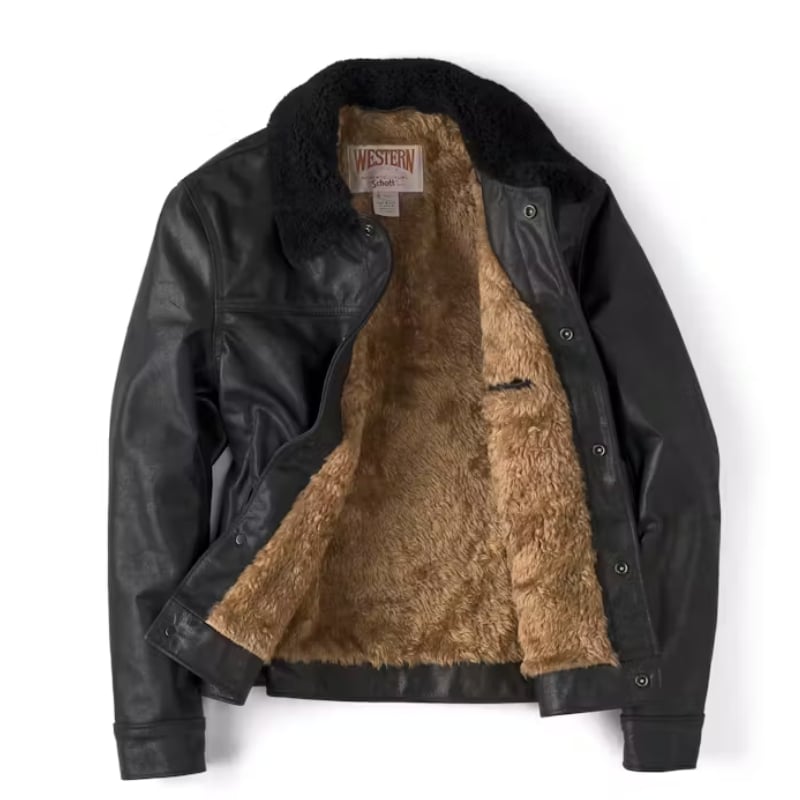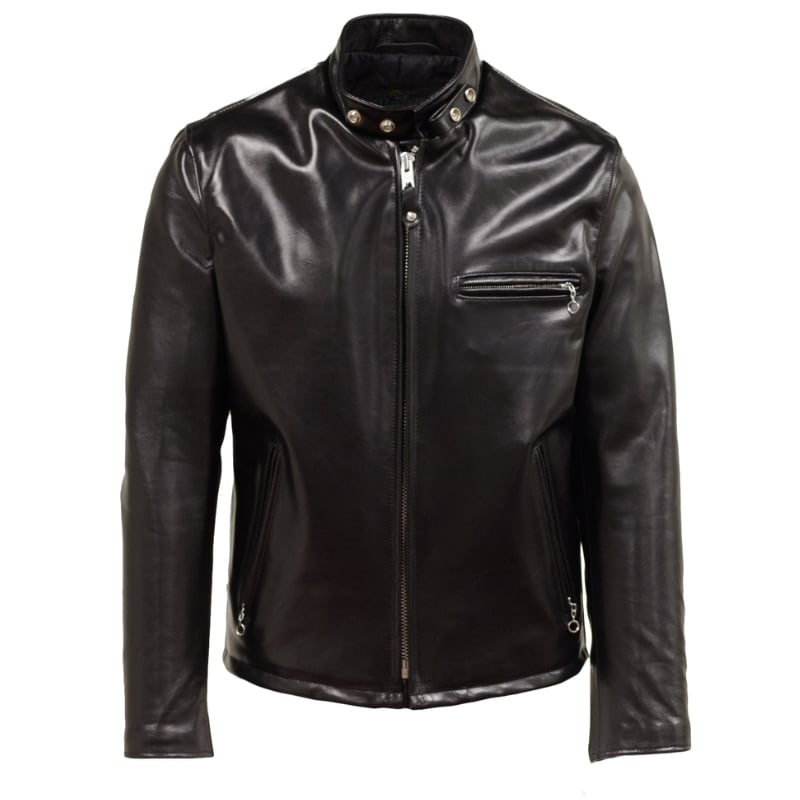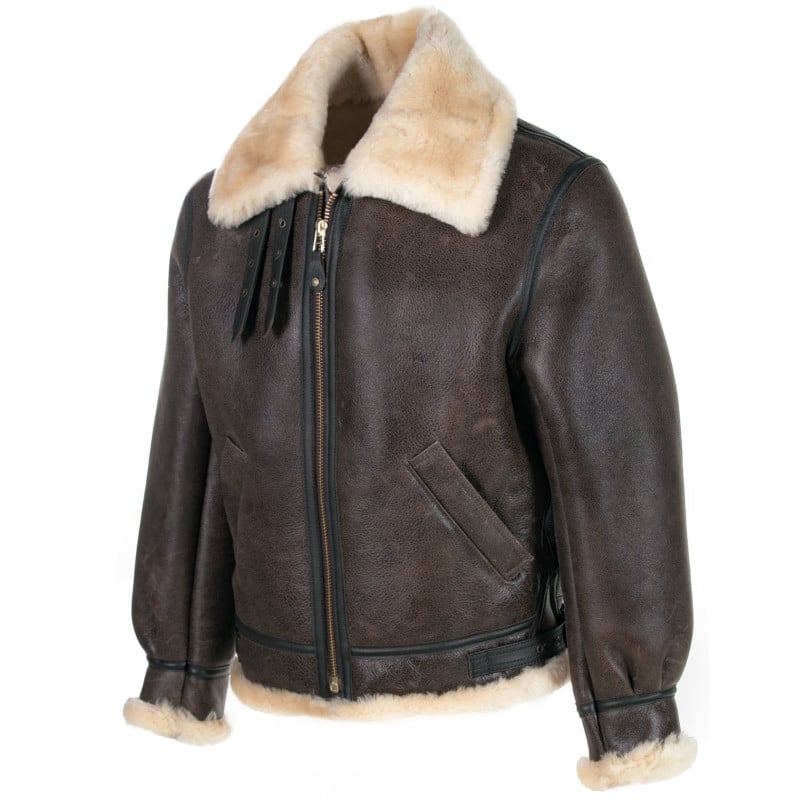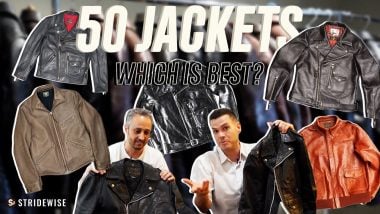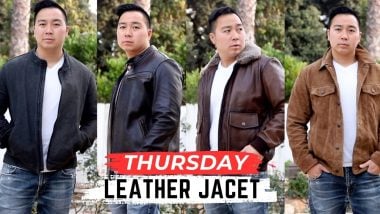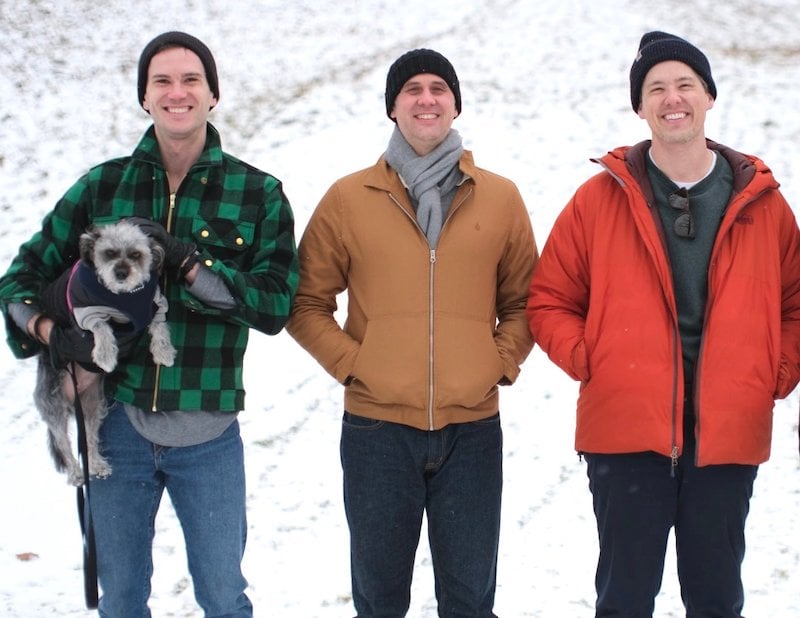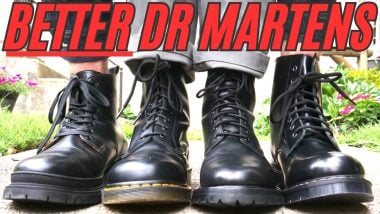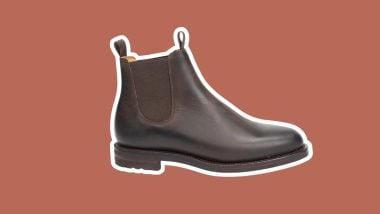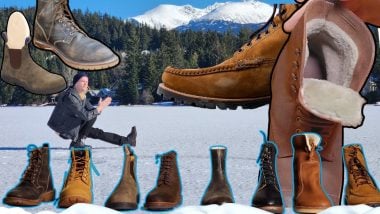Are Leather Jackets Warm? Expert Ranks 5 By Insulation
Everyone knows leather jackets are cool, but are they warm? Believe it or not, the boring answer is that it depends: some are unlined and made with more breathable leathers, while some deep winter jackets are straight up made from the skin of a sheep, with the wool still on.
And then there are jackets in between, so to help navigate the question of “are leather jackets warm,” I headed to the flagship Manhattan store of Schott NYC, perhaps America’s most legendary leather jacket brand.
None other than Jason Schott, great-grandson of the company’s founder, helped rank five iconic jackets from least to most warm. Watch it below, or scroll to read it!
Are Leather Jackets Good For Cold Weather?
- Leather acts like a protective shell; how it’s lined or insulated has the greatest impact on its warmth
“I think the first place to start is that leather inherently has pores. It’s a breathable material,” Jason explained. “It can be comfortable in a lot of different temperatures. You can add linings as well as just layering to wear leather way down into below freezing temperatures.”
Leather varies by hide — different animals produce different kinds of leather, but the tannery can also make a huge variety of materials from the same animal hide. The same cowhide, for example, can produce a leather that’s heavyweight or lightweight, but the way it’s tanned and processed can also produce a range of different levels of softness, stretchiness, and breathability.
In other words, the answer to “Are leather jackets warm?” depends on the properties of the particular jacket, and you need to ask whoever’s selling the particular model you’re looking at.

At its core, a jacket’s warmth depends on two things: the heat retention of the leather (the shell) and the insulation beneath it (be it the jacket’s lining or the layers you wear underneath).
Truthfully, the lining and what you wear underneath it will affect warmth more than the kind of leather.
In the winter, you want a dense leather that keeps warm air close and blocks wind and rain — 1.1 to 1.3 millimeters, or 3 ounces in leatherworker speak, is considered midweight.
Again, it’s more complicated: a leather imbued with a lot of oils and waxes, for example, improves waterproofness and longevity while hampering breathability. Truthfully, the lining and what you wear underneath it will affect warmth more than the kind of leather. Still, look for a jacket described as midweight or heavyweight.

Without a proper lining, even the thickest leather won’t hold much warmth. This is why it’s very rare to find an unlined leather jacket.
A midweight leather blocks the elements and breathes moderately well, but real cold-weather comfort comes only when you pair it with a proper insulating layer like wool, down, cotton, or synthetics like smooth nylon or furry acrylic. Alternatively, wear a super warm wool sweater underneath.
While this list includes jackets that range from unlined and lightweight to insulated for subzero temperatures, most of them land somewhere in the middle. You’re going to learn exactly what to wear when.
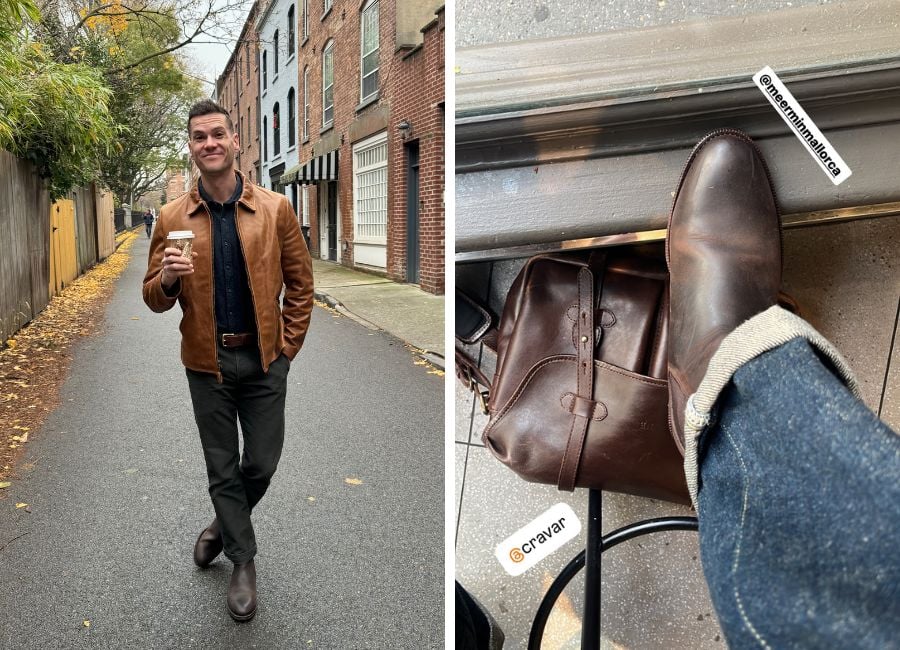
Leather’s Strengths
- Breathable: Leather has pores. This means it can be surprisingly comfortable across a range of temperatures.
- Wind Resistant: One of leather’s best abilities is its power to block wind.
- Versatility: With different leathers and linings, you can find a leather jacket with the appropriate insulation for almost any climate or occasion
- Layering: The right leather jacket can be the perfect outer shell, allowing you to layer underneath for serious cold.
Further Reading
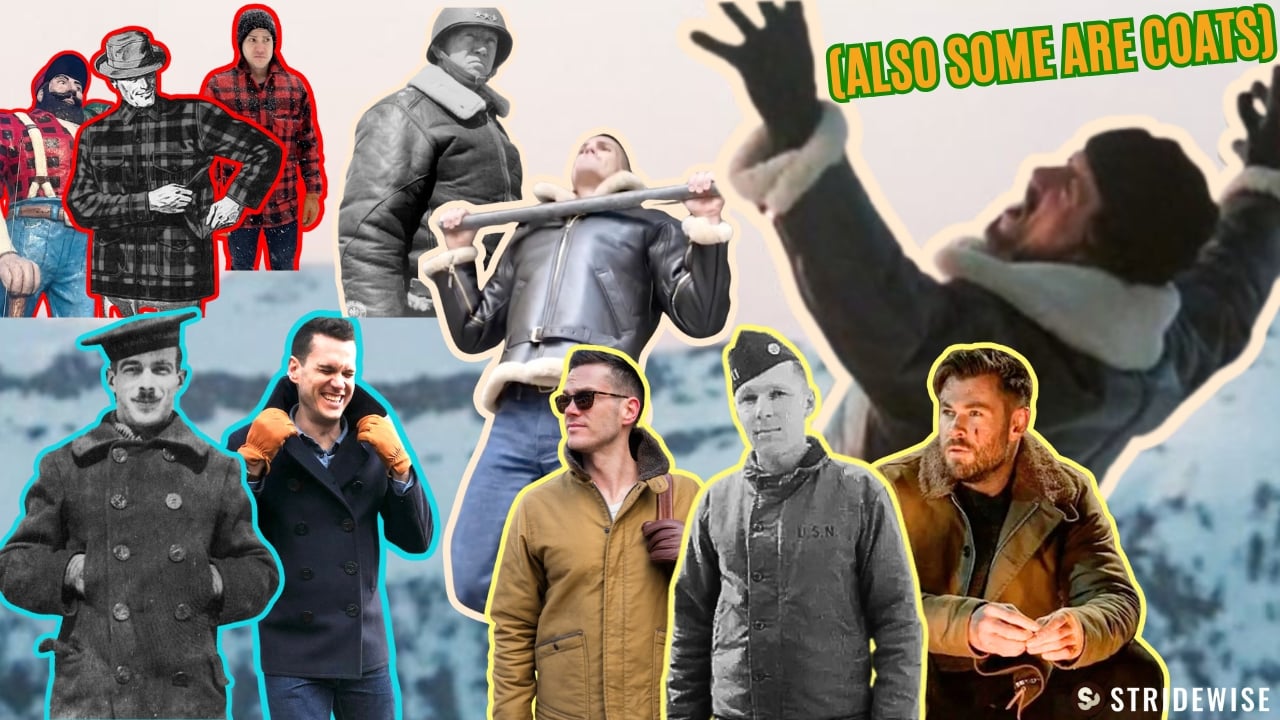
The 6 Best Winter Jackets (That are Actually Stylish)
We go into detail about the warmest and best-looking winter jackets. Learn more →
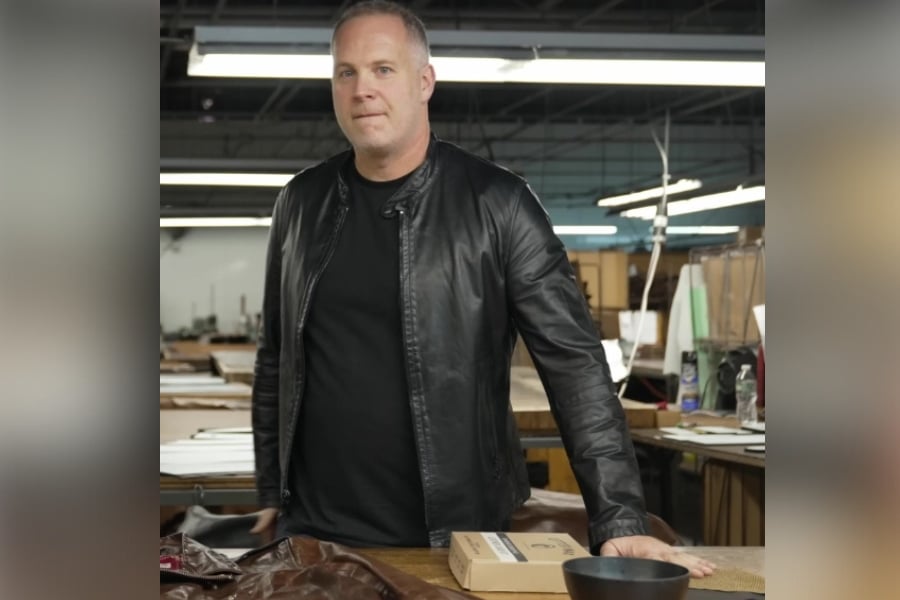
For Warm Weather: A Lightweight, Unlined Leather Jacket
- Ideal Model: Mission (P571) / Lightweight Trucker (582)
- Outer Shell: Lightweight cowhide (~0.9mm / 2 oz)
- Body Lining: Unlined
- Use: Works like a blazer or sports coat; easy to wear indoors and on warmer days
An important note: when talking about jackets, “lightweight” is 1 millimeter thick or less, also measured as 2 ounces. Midweight is 1.1 to 1.3 millimeters (3 ounces), and heavyweight is 1.4 millimeters (4 ounces) and up. You’re unlikely to find a jacket with leather that’s heavier than 4 ounces, but at that weight, it can stand up on its own. It’s thick.
Back to the lightweight jacket, though.
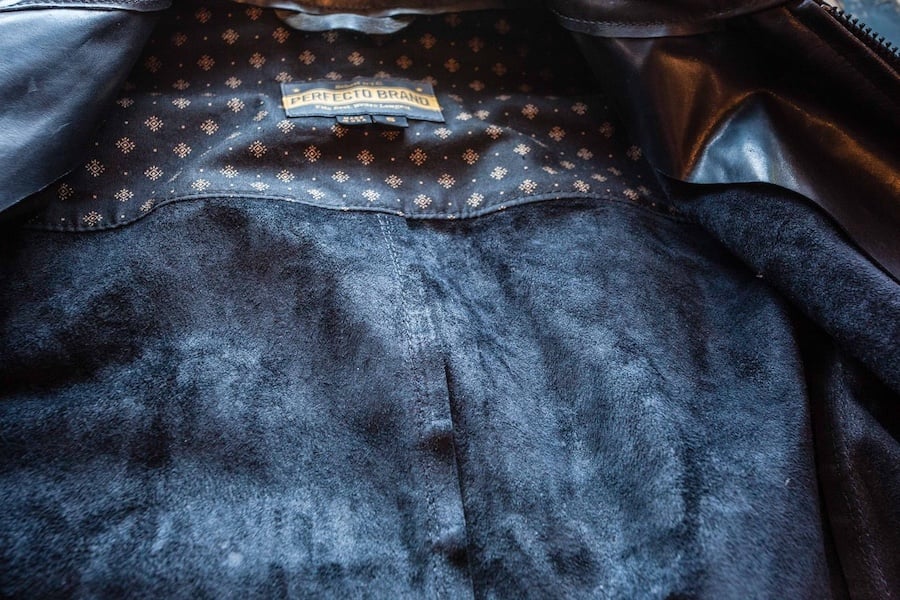
“I call this my indoor leather jacket,” says Jason. “They’re great when you’re going in and out of stores, when you’re not always outside all the time, and so you want something breathable that will adjust to your temperature.”
Unlined leather jackets, like Jason’s Mission P571 or the slightly thicker 581 Racer, are great options when you want the unbeatable leather jacket aesthetic but you’re not going anywhere, especially, well, cold. As someone who grew up in subtropical Australia, this would have been perfect for me.
“Even in warm temperatures, leather is very versatile because it is nice and breathable,” says Jason.
Made from an extra lightweight leather without any lining, this is the perfect leather jacket for warm weather or for wearing inside. Expect no break in.
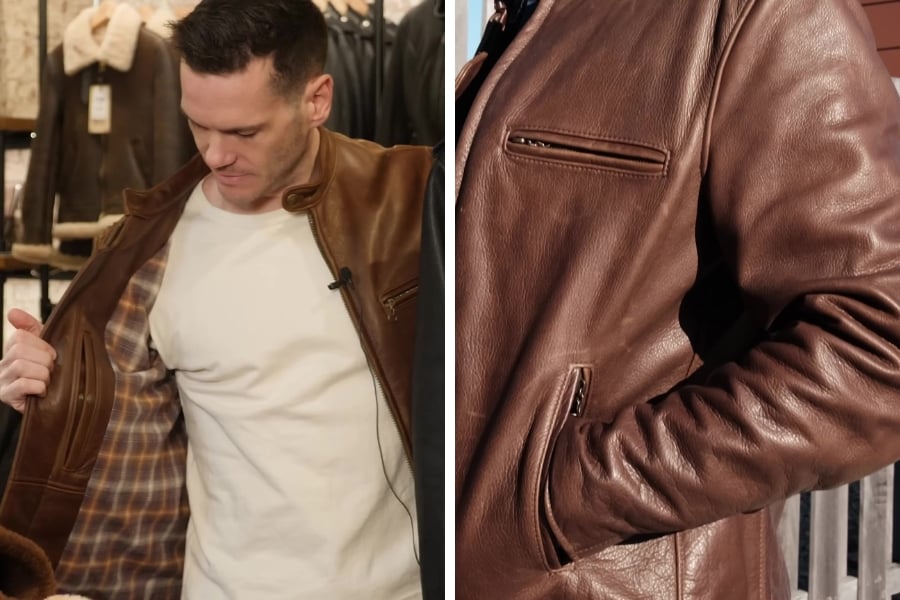
For Fall Weather: A Cotton or Nylon Lined Midweight Leather Jacket
- Good Models: Cafe Racer (530) / Perfecto (626)
- Outer Shell: Midweight cowhide (~1.2 mm / 3oz)
- Body Lining: Cotton flannel
- Use: 40 – 60 degrees F
Think of this as the default leather jacket; not too warm, not too cold, the leather is midweight and the lining is cotton flannel, though nylon or polysatin in the body is fine too. This is how most leather jackets are made, and it’s probably right for you.
This is the kind of jacket that will get the most wear: I’ve worn my Cafe Racer for years, and it gets so much wear because it works with a t-shirt on mild days, or I can slip a hoodie underneath it and feel comfortable in freezing temperatures.
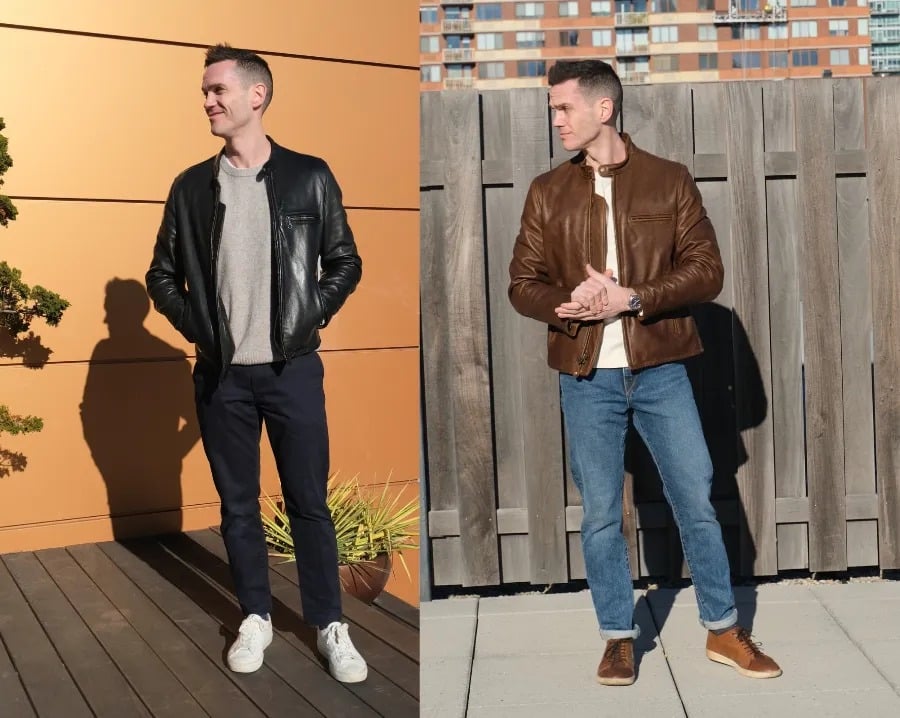
Racer jackets are identified by their mandarin-style collar (also called a band collar), short length, and relatively minimalist look. The design gained widespread popularity in the 1960s, fueled by World War II veterans who wanted a less overbuilt jacket for shorter trips on their motorcycles.
“If it’s springtime, a jacket like this is going to be all right because it’s just leather and a cotton lining, it’s not super geared toward insulation,” says Jason.
The Perfecto is another iconic jacket that fits in this category, though this model is so popular that Schott has released a ton of different versions, most of which have more heavy duty lining. For the perfect midweight Perfecto, opt for the 626, which has cotton flannel lining.
The cotton flannel-lined cafe racer is the ideal balance of edgy and relaxed comfort.
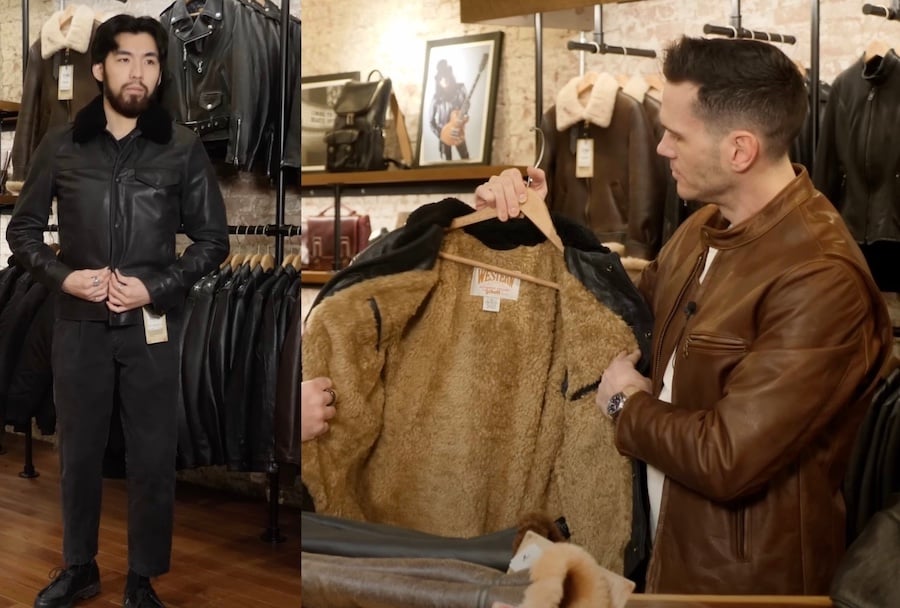
For Winter Weather: Sherpa Lined Leather Jackets
- Good Models: Buffalo Leather Trucker (545) / A-2 Flight Jacket (184SM) / Cafe Racer (141)
- Outer Shell: Midweight Buffalo / Cowhide (~3oz)
- Lining: Acrylic pile, a.k.a. sherpa
- Use: 25 to 45 degrees F
Let’s properly talk about lining in jackets. Wool is great when it’s well below freezing, but if you need something that’s warm-but-not-insanely-warm, consider sherpa. It looks like wool, brands sometimes imply that it’s wool, but it’s synthetic, typically made of polyester or acrylic.
“If you’re dropping down into the 40s, especially if you’re on a motorcycle, you want to have additional layers of insulation,” said Jason. “One option we offer is jackets with a zip-out liner. The sherpa lining the 545 leather trucker jacket is fixed, but the sherpa lining on the 184SM and 141 jackets is removable.”
That means you’re getting double the jacket: one for mild weather, and a sherpa-lined one for colder climes.

If you’re going to get just one leather jacket forever, it’s not a bad idea to have one with a zip-out lining.
“The flexibility allows you to take it out when it’s warm, but you put it in there when it gets below 40 degrees,” says Jason. “The acrylic is furry, soft, and very warm — plus it won’t irritate anyone with wool sensitivity.”
Made with durable, temperature-regulating buffalo leather and sherpa pile lining, this trucker style jacket is as stylish as it is warm.
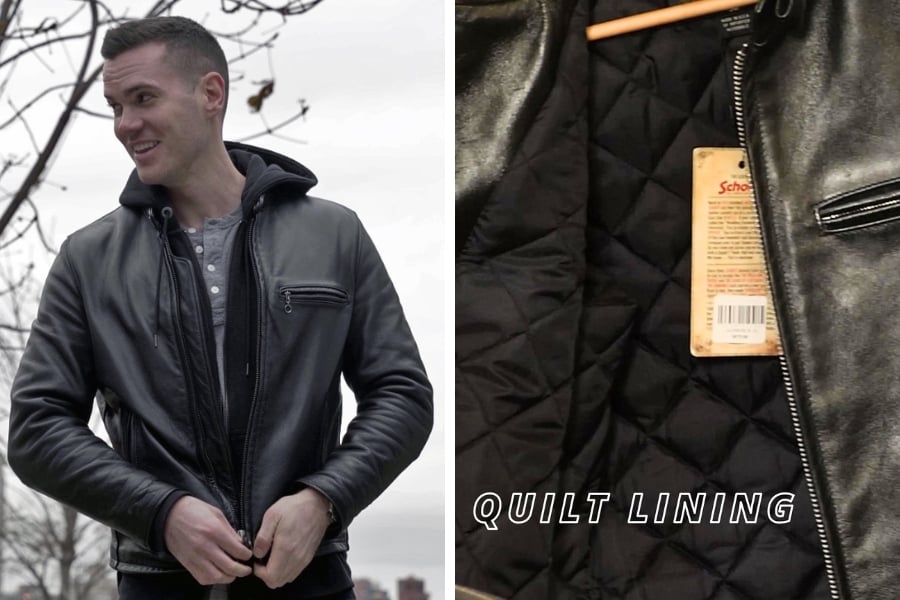
For Freezing Temperatures: Leather Jackets With Quilted Insulation
- Good Models: Cafe Racer (641HH) / Perfecto (618HH) / Buffalo Bomber (594)
- Outer Shell: Heavyweight Horsehide / Heavyweight Horsehide / Midweight Buffalo
- Lining: 5.5oz nylon poly quilt insulation
- Use: 20 to 40 degrees F
Once it’s freezing, folks want a heavyweight leather with thick lining, so this is where you’ll start to see more horsehide leather jackets recommended. Many of Schott’s best known designs, from cafe racers to Perfectos, are sold in horsehide with quilted lining.
Schott tends to use 5 to 6 ounces in their lining, meaning that’s the weight of the polyester insulation per square yard. It’s quilted to keep the filling from moving around the lining and ensure consistent warmth. Experts say 6 ounces should work for 20 degrees, but pack a sweater to be safe.
The quilted cafe racer has a very clean, slim look, two zippered hand warmer pockets, and warm lining.
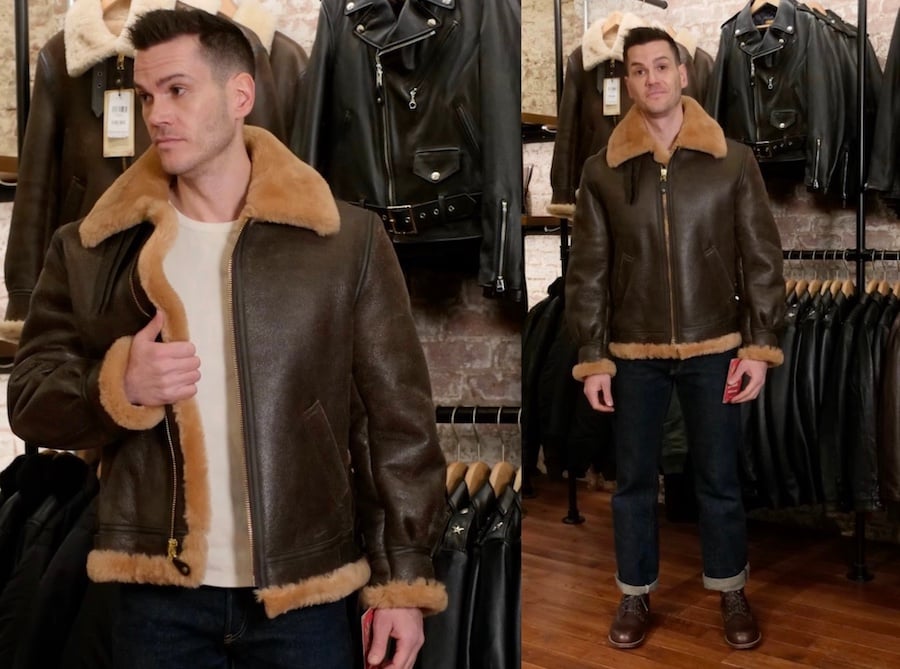
The Warmest Leather Jacket: Sheepskin Bombers
- Good Model: B-3 Sheepskin Leather Bomber (257S)
- Material: 100% Heavyweight Shearling
- Use: 0 degrees
Shearling is what you call sheepskin that’s been turned into leather without removing the wool: it’s the skin and the wool together, and it is unbelievably warm. If it’s not under 10 degrees, this jacket will probably be too much.
“The old bombers during World War II had heat in the cockpit, but not where the gunners sat on the wings,” says Jason. “They had to wear these extremely warm jackets, and the fur on the inside added protection for warmth and also acted as a moisture-wicking vehicle so that they weren’t sitting in their own sweat.”
Made to keep pilots warm in open cockpits, the B-3 is the classic WWII shearling leather "Bomber" jacket — there's practically nothing warmer. (Or cooler.)
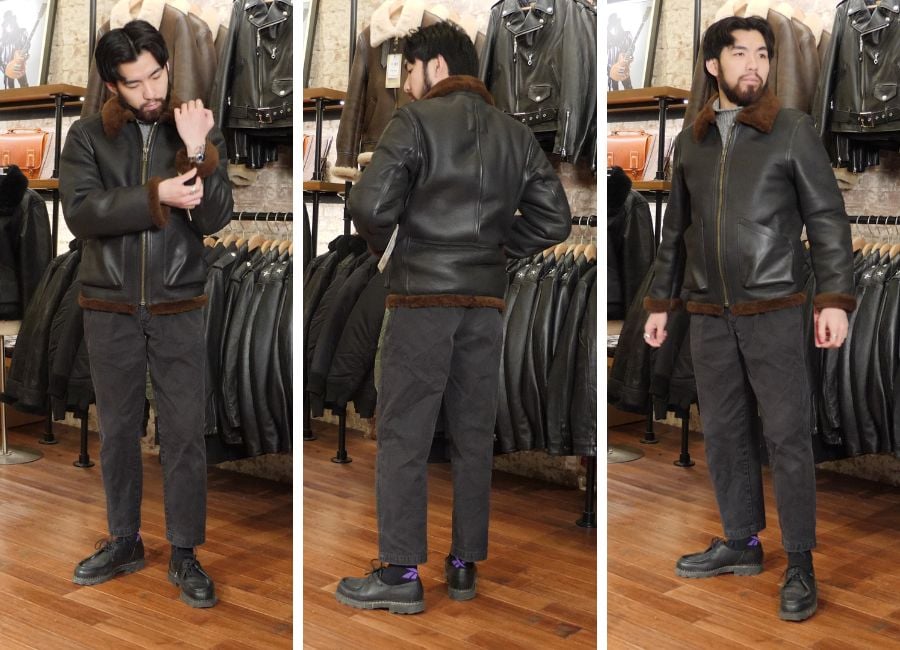
The shearling used for Schott’s B-3 is considered heavyweight and measured at three-quarters of an inch, though they also sell a model called the B-6: it has the same look but the shearling is half an inch, which makes it suitable to wear if the temperature hasn’t plunged below zero.
Another bonus of these jackets is that while the insulation on the previous jackets was just on the body, these have a layer of wool running all the way down the sleeves as well.
“Years ago, we made a shearling jacket that had two-inch fur, so more than twice as thick as the B-3, but it was definitely overkill and you could barely move in it — it was more of a runway piece than anything,” says Jason. “But the heavyweight B-3 will keep you warm well below zero. To be honest, a lot of people find it too warm to wear much.”
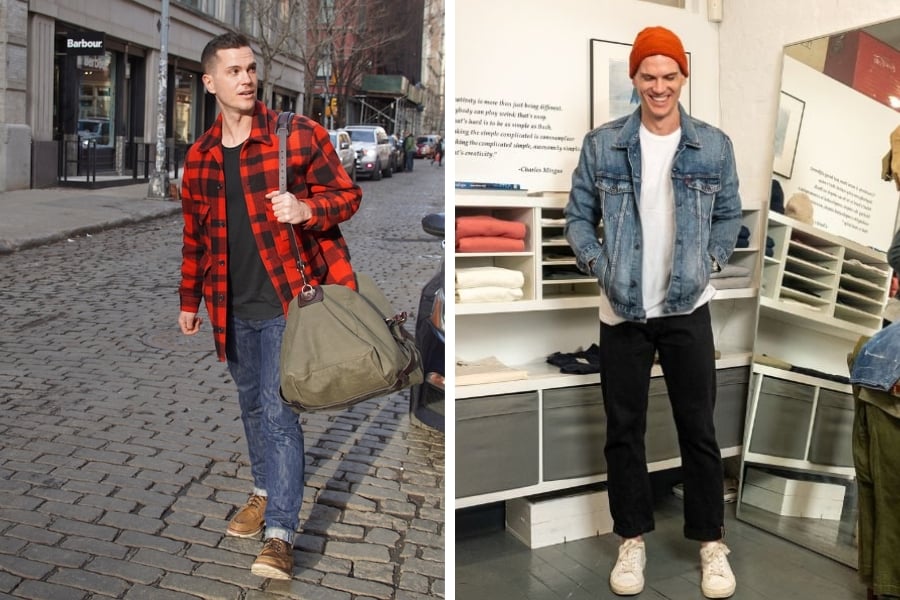
Is Leather Warmer than Denim or Wool?
- Denim doesn’t insulate well; it’s too porous
- Wool is a fantastic insulator and superior to leather
- Leather is somewhere in between; it’s denser than denim but lacks insulation unless you add a lining or layers
Denim jackets are not that warm: they’re unlined cotton. It’s popular as workwear because it provides protection without making you too warm.
Wool jackets are fantastically warm: they insulate well, keeping you warm in the cold without feeling too stuffy if it warms up.
Leather is somewhere in between, depending on its lining, thickness, and there are so many types.
“One thing you want to be careful about is putting silicone spray or any kind of finish on top of the leather,” said Jason. “Waterproofers can block the breathability of the leather and can make lightweight jackets less breathable.”
Are Some Types of Leather Warmer than Others?
- The type of animal the leather is made from doesn’t really affect warmth
- The thickness of the leather can have a slight effect in that lightweight leathers tend to be more breathable
Different leathers have different grain structures, so the animal that your leather comes from and the thickness of the leather can affect break-in, stiffness, comfort, durability, and the aesthetic, but not so much the warmth.
An exception is that lightweight leather breathes a little better, so the weight is important for warmth if you’re looking for a jacket that isn’t very warm. But if what you want is a jacket that is very warm, then your comfort will largely rely on how it’s lined or insulated.
Wrapping Up: Dressing for the Degrees
That full range of warmth is exactly what makes Schott NYC such a standout. They didn’t even pay us for this article; they just have the widest selection of leather jackets we could find.
Whether you need something for crisp fall mornings or subzero winter commutes, they’ve got you covered — literally.
Big thanks to Jason Schott for helping with this article, and make sure you see our other interviews with him below:


